Pultruded Pedestrian Fiberglass Grating: Uniform Load Deflection Table:
|
|
 |
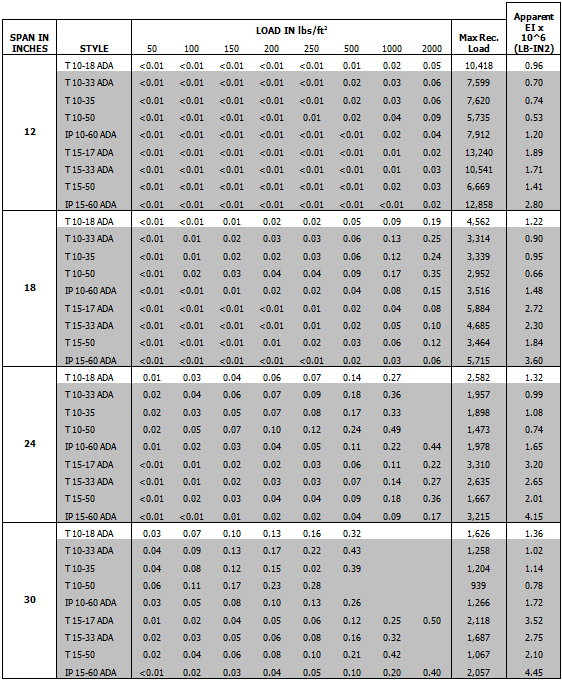 Notes:
Notes: T = T-Bar, I = I-Bar, IP = Pedestrian I-Bar, 10 = 1” Deep, 15 = 1 ½” Deep, -# = % Open, ex. T 10-18 = 1” Deep with 18% Open
ADA - Also an ADA compliant grating, Grey Highlight = Non-stocked item
- This table was developed in accordance with the test method developed by the Fiberglass Grating Manufacturers Council (FGMC) of the American Composites Manufacturers Association (ACMA) for the Fiberglass Grating Standard. The draft Standard can be reviewed at www.fiberglassgrating.org
- The designer should not exceed MAXIMUM RECOMMENDED load at any time. MAXIMUM LOAD represents a 2:1 factor of safety on ULTIMATE CAPACITY. ULTIMATE CAPACITY represents MAX LOAD observed at initial fracture.
- Walking loads for maintenance traffic are typically a live load of 50 PSF. Deflections for worker comfort are typically limited to 3/8" or SPAN divided by 120 under full live load. For a firmer feel under full live load or a line load 250 lbs/ft of width, limit deflections to 1/4" or SPAN divided by 200.
- The loads represented are for STATIC LOAD CONDITIONS at ambient temperature. Deflections for impact loads or dynamic loads will MULTIPLY the deflections shown by 2. Long term loads will result in added deflection due to creep in the material and will also require higher factors of safety to ensure acceptable performance.
- For applications at elevated temperatures, consult Canadian Composite Structures.
- Deflections are limited to ½" as recommended by the Fiberglass Grating Manufacturers Council of the American Composites Manufacturers Association
Pultruded Pedestrian Fiberglass Grating: Uniform Load Deflection Table:
|
|
 |
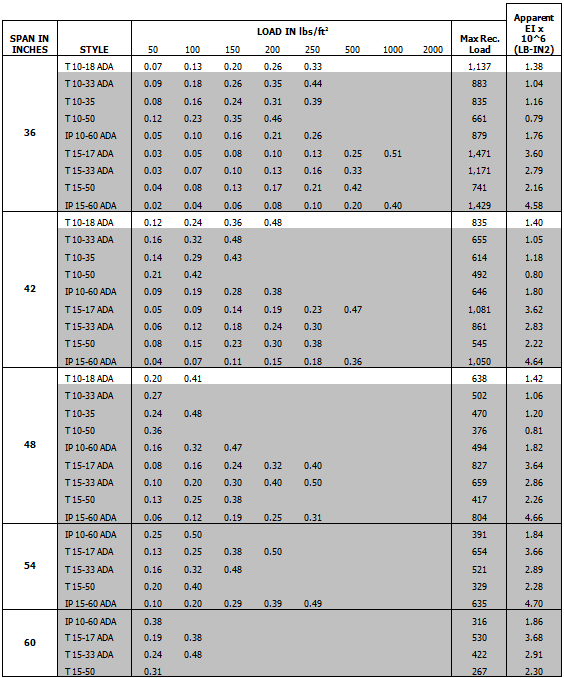 Notes:
Notes: T = T-Bar, I = I-Bar, IP = Pedestrian I-Bar, 10 = 1” Deep, 15 = 1 ½” Deep, -# = % Open, ex. T 10-18 = 1” Deep with 18% Open
ADA - Also an ADA compliant grating, Grey Highlight = Non-stocked item
- This table was developed in accordance with the test method developed by the Fiberglass Grating Manufacturers Council (FGMC) of the American Composites Manufacturers Association (ACMA) for the Fiberglass Grating Standard. The draft Standard can be reviewed at www.fiberglassgrating.org
- The designer should not exceed MAXIMUM RECOMMENDED load at any time. MAXIMUM LOAD represents a 2:1 factor of safety on ULTIMATE CAPACITY. ULTIMATE CAPACITY represents MAX LOAD observed at initial fracture.
- Walking loads for maintenance traffic are typically a live load of 50 PSF. Deflections for worker comfort are typically limited to 3/8" or SPAN divided by 120 under full live load. For a firmer feel under full live load or a line load 250 lbs/ft of width, limit deflections to 1/4" or SPAN divided by 200.
- The loads represented are for STATIC LOAD CONDITIONS at ambient temperature. Deflections for impact loads or dynamic loads will MULTIPLY the deflections shown by 2. Long term loads will result in added deflection due to creep in the material and will also require higher factors of safety to ensure acceptable performance.
- For applications at elevated temperatures, consult Canadian Composite Structures.
- Deflections are limited to ½" as recommended by the Fiberglass Grating Manufacturers Council of the American Composites Manufacturers Association
Pultruded Pedestrian Grating: Uniform Load Deflection Table:
|
|
 |
 Notes:
Notes: T = T-Bar, I = I-Bar, IP = Pedestrian I-Bar, 10 = 1” Deep, 15 = 1 ½” Deep, -# = % Open, ex. T 10-18 = 1” Deep with 18% Open
ADA - Also an ADA compliant grating, Grey Highlight = Non-stocked item
- This table was developed in accordance with the test method developed by the Fiberglass Grating Manufacturers Council (FGMC) of the American Composites Manufacturers Association (ACMA) for the Fiberglass Grating Standard. The draft Standard can be reviewed at www.fiberglassgrating.org
- The designer should not exceed MAXIMUM RECOMMENDED load at any time. MAXIMUM LOAD represents a 2:1 factor of safety on ULTIMATE CAPACITY. ULTIMATE CAPACITY represents MAX LOAD observed at initial fracture.
- Walking loads for maintenance traffic are typically a live load of 50 PSF. Deflections for worker comfort are typically limited to 3/8" or SPAN divided by 120 under full live load. For a firmer feel under full live load or a line load 250 lbs/ft of width, limit deflections to 1/4" or SPAN divided by 200.
- The loads represented are for STATIC LOAD CONDITIONS at ambient temperature. Deflections for impact loads or dynamic loads will MULTIPLY the deflections shown by 2. Long term loads will result in added deflection due to creep in the material and will also require higher factors of safety to ensure acceptable performance.
- For applications at elevated temperatures, consult Canadian Composite Structures.
- Deflections are limited to ½" as recommended by the Fiberglass Grating Manufacturers Council of the American Composites Manufacturers Association
Pultruded Pedestrian Fiberglass Grating
Concentrated Line Load Deflection Table:
|
|
 |
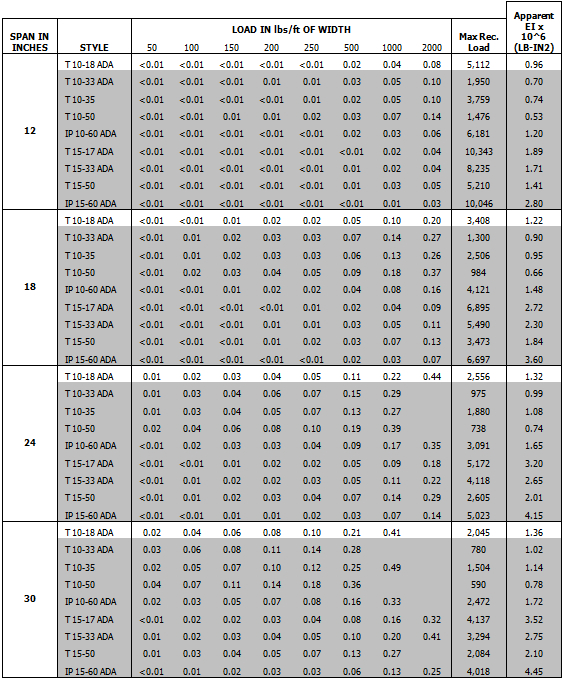 Notes:
Notes: T = T-Bar, I = I-Bar, IP = Pedestrian I-Bar, 10 = 1” Deep, 15 = 1 ½” Deep, -# = % Open, ex. T 10-18 = 1” Deep with 18% Open
ADA - Also an ADA compliant grating, Grey Highlight = Non-stocked item
- This table was developed in accordance with the test method developed by the Fiberglass Grating Manufacturers Council (FGMC) of the American Composites Manufacturers Association (ACMA) for the Fiberglass Grating Standard. The draft Standard can be reviewed at www.fiberglassgrating.org
- The designer should not exceed MAXIMUM RECOMMENDED load at any time. MAXIMUM LOAD represents a 2:1 factor of safety on ULTIMATE CAPACITY. ULTIMATE CAPACITY represents MAX LOAD observed at initial fracture.
- Walking loads for maintenance traffic are typically a live load of 50 PSF. Deflections for worker comfort are typically limited to 3/8" or SPAN divided by 120 under full live load. For a firmer feel under full live load or a line load 250 lbs/ft of width, limit deflections to 1/4" or SPAN divided by 200.
- The loads represented are for STATIC LOAD CONDITIONS at ambient temperature. Deflections for impact loads or dynamic loads will MULTIPLY the deflections shown by 2. Long term loads will result in added deflection due to creep in the material and will also require higher factors of safety to ensure acceptable performance.
- For applications at elevated temperatures, consult Canadian Composite Structures.
- Deflections are limited to ½" as recommended by the Fiberglass Grating Manufacturers Council of the American Composites Manufacturers Association
Pultruded Pedestrian Fiberglass Grating
Concentrated Line Load Deflection Table:
|
|
 |
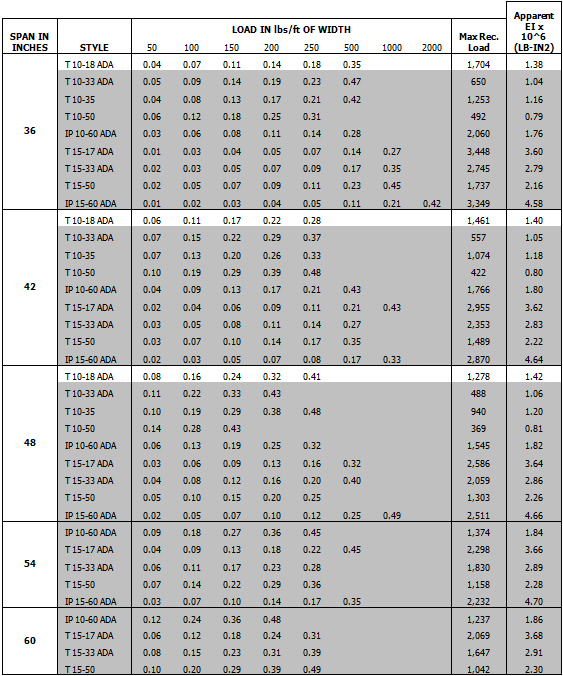 Notes:
Notes: T = T-Bar, I = I-Bar, IP = Pedestrian I-Bar, 10 = 1” Deep, 15 = 1 ½” Deep, -# = % Open, ex. T 10-18 = 1” Deep with 18% Open
ADA - Also an ADA compliant grating, Grey Highlight = Non-stocked item
- This table was developed in accordance with the test method developed by the Fiberglass Grating Manufacturers Council (FGMC) of the American Composites Manufacturers Association (ACMA) for the Fiberglass Grating Standard. The draft Standard can be reviewed at www.fiberglassgrating.org
- The designer should not exceed MAXIMUM RECOMMENDED load at any time. MAXIMUM LOAD represents a 2:1 factor of safety on ULTIMATE CAPACITY. ULTIMATE CAPACITY represents MAX LOAD observed at initial fracture.
- Walking loads for maintenance traffic are typically a live load of 50 PSF. Deflections for worker comfort are typically limited to 3/8" or SPAN divided by 120 under full live load. For a firmer feel under full live load or a line load 250 lbs/ft of width, limit deflections to 1/4" or SPAN divided by 200.
- The loads represented are for STATIC LOAD CONDITIONS at ambient temperature. Deflections for impact loads or dynamic loads will MULTIPLY the deflections shown by 2. Long term loads will result in added deflection due to creep in the material and will also require higher factors of safety to ensure acceptable performance.
- For applications at elevated temperatures, consult Canadian Composite Structures.
- Deflections are limited to ½" as recommended by the Fiberglass Grating Manufacturers Council of the American Composites Manufacturers Association
Pultruded Pedestrian Fiberglass Grating
Concentrated Line Load Deflection Table:
|
|
 |
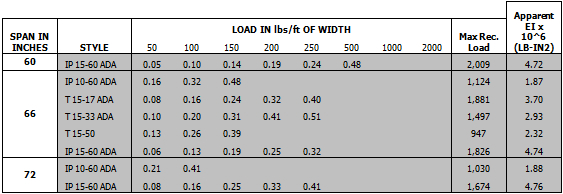 Notes:
Notes: T = T-Bar, I = I-Bar, IP = Pedestrian I-Bar, 10 = 1” Deep, 15 = 1 ½” Deep, -# = % Open, ex. T 10-18 = 1” Deep with 18% Open
ADA - Also an ADA compliant grating, Grey Highlight = Non-stocked item
- This table was developed in accordance with the test method developed by the Fiberglass Grating Manufacturers Council (FGMC) of the American Composites Manufacturers Association (ACMA) for the Fiberglass Grating Standard. The draft Standard can be reviewed at www.fiberglassgrating.org
- The designer should not exceed MAXIMUM RECOMMENDED load at any time. MAXIMUM LOAD represents a 2:1 factor of safety on ULTIMATE CAPACITY. ULTIMATE CAPACITY represents MAX LOAD observed at initial fracture.
- Walking loads for maintenance traffic are typically a live load of 50 PSF. Deflections for worker comfort are typically limited to 3/8" or SPAN divided by 120 under full live load. For a firmer feel under full live load or a line load 250 lbs/ft of width, limit deflections to 1/4" or SPAN divided by 200.
- The loads represented are for STATIC LOAD CONDITIONS at ambient temperature. Deflections for impact loads or dynamic loads will MULTIPLY the deflections shown by 2. Long term loads will result in added deflection due to creep in the material and will also require higher factors of safety to ensure acceptable performance.
- For applications at elevated temperatures, consult Canadian Composite Structures.
- Deflections are limited to ½" as recommended by the Fiberglass Grating Manufacturers Council of the American Composites Manufacturers Association